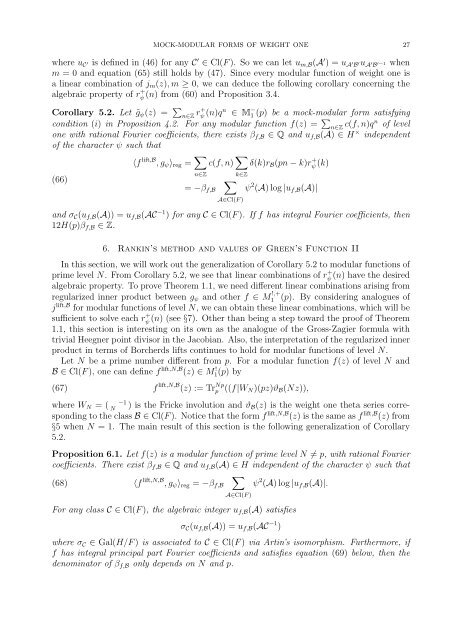Mock-modular forms of weight one - UCLA Department of Mathematics
Mock-modular forms of weight one - UCLA Department of Mathematics
Mock-modular forms of weight one - UCLA Department of Mathematics
You also want an ePaper? Increase the reach of your titles
YUMPU automatically turns print PDFs into web optimized ePapers that Google loves.
MOCK-MODULAR FORMS OF WEIGHT ONE 27<br />
where u C ′ is defined in (46) for any C ′ ∈ Cl(F ). So we can let u m,B (A ′ ) = u A ′ B ′u A ′ B ′−1 when<br />
m = 0 and equation (65) still holds by (47). Since every <strong>modular</strong> function <strong>of</strong> <strong>weight</strong> <strong>one</strong> is<br />
a linear combination <strong>of</strong> j m (z), m ≥ 0, we can deduce the following corollary concerning the<br />
algebraic property <strong>of</strong> r + ψ<br />
(n) from (60) and Proposition 3.4.<br />
Corollary 5.2. Let ˜g ψ (z) = ∑ n∈Z r+ ψ (n)qn ∈ M − 1 (p) be a mock-<strong>modular</strong> form satisfying<br />
condition (i) in Proposition 4.2. For any <strong>modular</strong> function f(z) = ∑ n∈Z c(f, n)qn <strong>of</strong> level<br />
<strong>one</strong> with rational Fourier coefficients, there exists β f,B ∈ Q and u f,B (A) ∈ H × independent<br />
<strong>of</strong> the character ψ such that<br />
(66)<br />
〈f lift,B , g ψ 〉 reg = ∑ c(f, n) ∑ δ(k)r B (pn − k)r + ψ (k)<br />
n∈Z k∈Z<br />
∑<br />
= −β f,B ψ 2 (A) log |u f,B (A)|<br />
A∈Cl(F )<br />
and σ C (u f,B (A)) = u f,B (AC −1 ) for any C ∈ Cl(F ). If f has integral Fourier coefficients, then<br />
12H(p)β f,B ∈ Z.<br />
6. Rankin’s method and values <strong>of</strong> Green’s Function II<br />
In this section, we will work out the generalization <strong>of</strong> Corollary 5.2 to <strong>modular</strong> functions <strong>of</strong><br />
prime level N. From Corollary 5.2, we see that linear combinations <strong>of</strong> r + ψ<br />
(n) have the desired<br />
algebraic property. To prove Theorem 1.1, we need different linear combinations arising from<br />
regularized inner product between g ψ and other f ∈ M !,+<br />
1 (p). By considering analogues <strong>of</strong><br />
j lift,B for <strong>modular</strong> functions <strong>of</strong> level N, we can obtain these linear combinations, which will be<br />
sufficient to solve each r + ψ<br />
(n) (see §7). Other than being a step toward the pro<strong>of</strong> <strong>of</strong> Theorem<br />
1.1, this section is interesting on its own as the analogue <strong>of</strong> the Gross-Zagier formula with<br />
trivial Heegner point divisor in the Jacobian. Also, the interpretation <strong>of</strong> the regularized inner<br />
product in terms <strong>of</strong> Borcherds lifts continues to hold for <strong>modular</strong> functions <strong>of</strong> level N.<br />
Let N be a prime number different from p. For a <strong>modular</strong> function f(z) <strong>of</strong> level N and<br />
B ∈ Cl(F ), <strong>one</strong> can define f lift,N,B (z) ∈ M 1(p) ! by<br />
(67) f lift,N,B (z) := Tr Np<br />
p ((f|W N )(pz)ϑ B (Nz)),<br />
−1<br />
where W N = (<br />
N<br />
) is the Fricke involution and ϑ B (z) is the <strong>weight</strong> <strong>one</strong> theta series corresponding<br />
to the class B ∈ Cl(F ). Notice that the form f lift,N,B (z) is the same as f lift,B (z) from<br />
§5 when N = 1. The main result <strong>of</strong> this section is the following generalization <strong>of</strong> Corollary<br />
5.2.<br />
Proposition 6.1. Let f(z) is a <strong>modular</strong> function <strong>of</strong> prime level N ≠ p, with rational Fourier<br />
coefficients. There exist β f,B ∈ Q and u f,B (A) ∈ H independent <strong>of</strong> the character ψ such that<br />
∑<br />
(68) 〈f lift,N,B , g ψ 〉 reg = −β f,B ψ 2 (A) log |u f,B (A)|.<br />
A∈Cl(F )<br />
For any class C ∈ Cl(F ), the algebraic integer u f,B (A) satisfies<br />
σ C (u f,B (A)) = u f,B (AC −1 )<br />
where σ C ∈ Gal(H/F ) is associated to C ∈ Cl(F ) via Artin’s isomorphism. Furthermore, if<br />
f has integral principal part Fourier coefficients and satisfies equation (69) below, then the<br />
denominator <strong>of</strong> β f,B only depends on N and p.
















